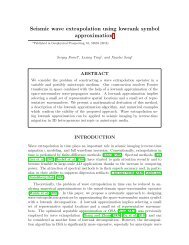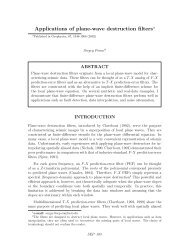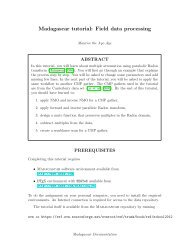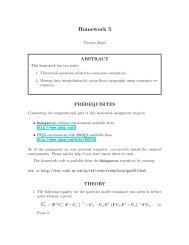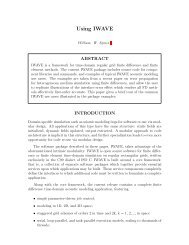pdf 260K - Madagascar
pdf 260K - Madagascar
pdf 260K - Madagascar
You also want an ePaper? Increase the reach of your titles
YUMPU automatically turns print PDFs into web optimized ePapers that Google loves.
2<br />
(a) Transform the isotropic ray tracing system<br />
dp<br />
dσ<br />
= S(x) ∇S (1)<br />
dx<br />
dσ = p (2)<br />
dT<br />
dσ = S2 (x) (3)<br />
into an equivalent system that uses ξ instead of σ, where ξ is constrained<br />
by equation (4):<br />
dp<br />
dξ<br />
dx<br />
dξ<br />
dT<br />
dξ<br />
What are the physical units of ξ?<br />
= ∇S<br />
S 2 (x)<br />
(4)<br />
= (5)<br />
= (6)<br />
(b) Suppose you are given T (x) – the traveltime from the source to all points<br />
x in the domain of interest. Your task is to find ξ(x) for all x. Derive a<br />
first-order partial differential equation that connects ∇ξ and ∇T .<br />
2. The so-called “parabolic” or 15 ◦ eikonal equation (Tappert, 1977; Claerbout,<br />
1985; Bamberger et al., 1988) has the form<br />
∂T<br />
+ 1<br />
∂x 1 2 S(x)<br />
( ∂T<br />
∂x 2<br />
) 2<br />
= S(x) (7)<br />
where x = {x 1 , x 2 } is a point in space, T (x) is the traveltime, and S(x) is<br />
slowness.<br />
(a) Derive the ray tracing system for equation (7)<br />
dx 2<br />
dx 1<br />
= (8)<br />
dp 1<br />
dx 1<br />
= (9)<br />
dp 2<br />
dx 1<br />
= (10)<br />
dT<br />
dx 1<br />
= (11)<br />
where p 1 represents ∂T/∂x 1 and p 2 represents ∂T/∂x 2 .<br />
(b) Assuming constant slowness S(x) ≡ S 0 , solve the ray tracing system for a<br />
point source at the origin {x 1 , x 2 } = {0, 0}.




